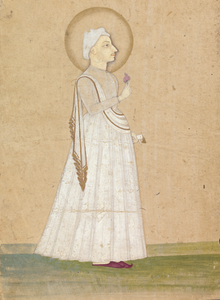Peshwa
Peshwa , from the Persian پیشوا pēshwā or pišwā , "leader, leader", was a title of office and ruler in north-west India . He referred mainly prime minister and home Meier of Marathenreichs , hindi पेशवा, marathi पेशवे.
Etymology and Origin
Peshwa was already the title of First Minister in earlier Muslim rulers in India; it occurs as early as 1152 with the Muslim Ghurid ruler Ala-ud-din (1149–1161). Since 1397 it has been used for one of the ministers in the Bahmani Sultanate , but especially since the end of the 17th century. for the mighty Prime Ministers of the Marathas Empire .
The Marathen Peshwas

The Peshwa office was from the Marathenherrschern , the rajas of Satara , since the time of the founder Shivaji (around 1630-1680) with Brahmins occupied and designated first the chairman of Shivaji Achterrat ( Ashtapradhan ).
The first Peshwa under Shivaji
The first Peshwa of the Marathas was Moropant Trimbak Pingle (1620–1683, Peshwa since 1674). With the rise of the Citpavan Brahmans from the coast, who initially held subordinate administrative and tax offices as financial experts, into the Peshwa office and after their reorganization of the tax, administrative and military apparatus, not only lost the actual princely dynasty of the Bhonsle , but also the surrounding, previously influential nobles and established Deshastha Brahmans became more and more important.
Rise to house fights
The Peshwas waged war, conquered entire regions as generals, concluded treaties and collected taxes, but officially always in the name of the Rajas of Satara, whom they kept in captivity there. In 1713 their office under Prince Baji Rao I , called Nanasaheb , (1720–1761, see picture above) became hereditary in the family. Amazingly, the prudent Ramchandra Pant Amatya (1650–1716), himself Peshwa, the ruling family in his writing Ajnya patra , a princely mirror in the sense of Kautilya's Arthashastra or Machiavelli's Il Principe , seems to have warned of this fateful development for the princely house as early as 1716 .
Decline

Towards the end of the century, the Peshwa in Pune itself became a puppet of powerful ministers like Nana Fadnavis , the "Indian Machiavelli" (Grant Duff). The generals founded their own successor states, such as the Sindia of Gwalior , the Holkar of Indore and the Gaekwad of Baroda . The Peshwa or his minister succeeded in making the Maratha states dependent on themselves and forcing them into vassal relationships from their residence - since 1749 the nearby Pune - but the catastrophic defeat in the Battle of Panipat against them Afghans 1761 meant the failure of their military and political strategy, even if under the government of Madhav Rao I (* 1745, r. 1761–1772, † 1772) there was once again a brief renaissance of the united Marathi power.
The Peshwas as British pensioners
In 1802 the Peshwa became dependent on the British East India Company during the internal disputes , which - in ignorance of the existence of the real ruler, the Raja of Satara from the House of Bhonsle - mistook him for the actual king.
After the Third Marath War 1817-18 the last Peshwa, Baji Rao II. (1775-1851), lost his office in 1818, accepted an annual pension from the British and spent the last three decades of his life as a pensioner of the East India Company under the eyes of the British Bithur near Kanpur . His adopted son Nana Sahib (1824–1857) played a leading role in the great uprising of 1857 .
The royal house of Bhonsle after the fall of the Peshwas
The actual principality with the court of the Bhonsle of Satara remained as a protectorate, but became after the death of the last (adopted) Raja, Appa Saheb Bhonsle III. (1802-1848, r. 1839-1848), who had no male heirs, was the first reversion to be captured by the British according to the Doctrine of Lapse .
List of Peshwas
- Balaji Vishwanath (1713-20)
- Baji Rao I (1720-40)
- Balaji Baji Rao (1740-61)
- Madhav Rao I. Ballal (1761–72)
- Narayan Rao (1772–73)
- Ragunath (1773–74; pretender)
- Madhav Rao II Narayan (1774-95)
- Baji Rao II (1796-1818)
Individual evidence
- ↑ Balfour, Cyclopaedia Vol III, p. 190
- ↑ Eaton, Deccan, p. 185; Wink, Peshwa, p. 300
- ↑ Wink, Peshwa
- ↑ The work is traditionally attributed to Ramchandra Pant Amatya; Jan Gonda : History of Indian Literature . Wiesbaden: Harrassowitz 1974. p. 447
- ^ Revival of Maratha Power (1761-1772) . Bombay: Gov. Central Press 1962.
- ↑ Wink, Peshwa
- ↑ Mehra, Dictionary pp. 64-66
- ↑ The branch line of the Bhonsle-Marathen from Kolhapur, however, remained until Indian independence.
literature
- James Grant Duff [former political resident in Satara]: A History of the Mahrattas. With copious notes . 3 vols. London: Longman u. a. 1826 online version .
- Edward [Green] Balfour (Ed.): The Cyclopaedia of India and of Eastern and Southern Asia, Commercial, Industrial, and Scientific; Products of the Mineral, Vegetable, and Animal Kingdoms, Useful Arts and Manufactures. 3 vols. 3rd ed. London: Quaritch 1885 (ND Graz 1968). Vol. Iii p. 190 sv Peshwa. - 1st edition Madras 1857, 2nd edition 1871–1873.
- Parshotam Mehra: A Dictionary of Modern Indian History 1707-1947 . Delhi u. a. : Oxford University Press 1985 (reprinted 1987)
- Richard M. Eaton: A Social History of the Deccan, 1300-1761 . Cambridge et al. a. : CUP 2005. (The New Cambridge History of India I, 8)
- André Wink: Peshwa . In: The Encyclopaedia of Islam. New Edition. Leiden: Brill 1993. Vol. Viii, p. 300 f.

